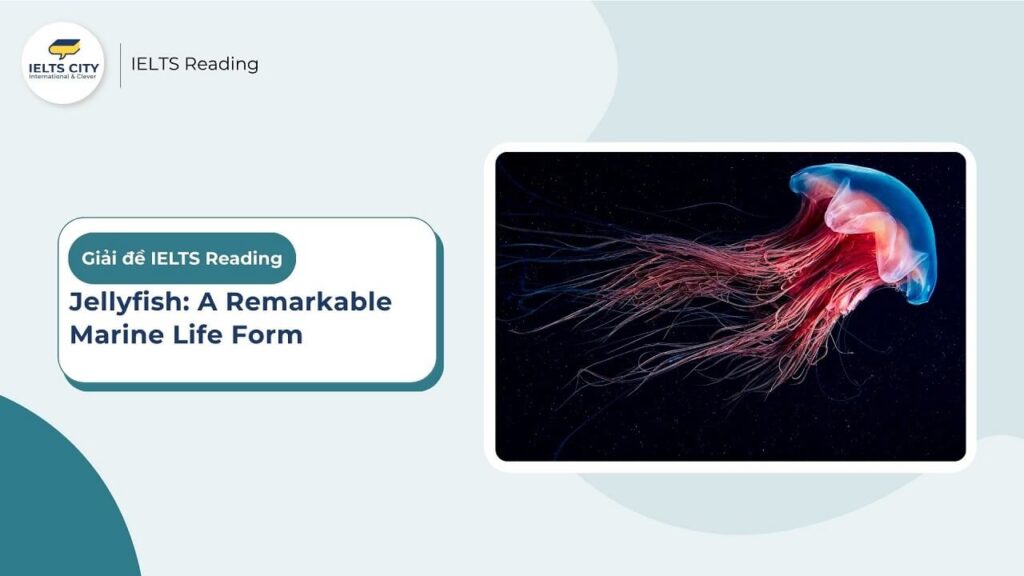
Nội dung chính
ToggleBài đọc
Jellyfish: A Remarkable Marine Life Form
When viewed in the wild, jellyfish are perhaps the most graceful and vividly coloured of all sea creatures. But few people have seen a jellyfish living in its natural habitat. Instead, they might see a dead and shapeless specimen lying on the beach, or perhaps receive a painful sting while swimming, so it is inevitable that jellyfish are often considered ugly and possibly dangerous. This misunderstanding can be partly traced back to the 20th century, when the use of massive nets and mechanical winches often damaged the delicate jellyfish that scientists managed to recover. As a result, disappointingly little research was carried out into jellyfish, as marine biologists took the easy option and focused on physically stronger species such as fish, crabs and shrimp. Fortunately, however, new techniques are now being developed. For example, scientists have discovered that sound bounces harmlessly off jellyfish, so in the Arctic and Norway researchers are using sonar to monitor jellyfish beneath the ocean’s surface. This, together with aeroplane surveys, satellite imagery and underwater cameras, has provided a wealth of new information in recent years.
Scientists know believe that in shallow water alone there are at least 38 million tonnes of jellyfish and these creatures inhabit every type of marine habitat, including deep water. Furthermore, jellyfish were once regarded as relatively solitary, but this is another area where science has evolved. Dr Karen Hansen was the first to suggest that jellyfish are in fact the centre of entire ecosystems, as shrimp, lobster, and fish shelter and feed among their tentacles. This proposition has subsequently been conclusively proven by independent studies. DNA sequencing and isotope analysis have provided further insights, including the identification of numerous additional species of jellyfish unknown to science only a few years ago.
This brings us to the issue of climate change. Research studies around the world have recorded a massive growth in jellyfish populations in recent years and some scientists have linked this to climate change. However, while this may be credible, it cannot be established with certainty as other factors might be involved. Related to this was the longstanding academic belief that jellyfish had no predators and therefore there was no natural process to limit their numbers. However, observations made by Paul Dewar and his team showed that this was incorrect. As a result, the scientific community now recognises that species including sharks, tuna, swordfish and some salmon all prey on jellyfish.
It is still widely assumed that jellyfish are among the simplest lifeforms, as they no brain or central nervous system. While this is true, we now know they possess senses that allow them to see, feel and interact with their environment on subtle ways. What is more, analysis of so-called ‘upside-down jellyfish’ shows that they shut down their bodies and rest in much the same way that humans do at night, something once widely believed to be impossible for jellyfish. Furthermore, far from ‘floating’ in the water as they are still sometimes thought to do, analysis has shown jellyfish to be the most economical swimmers in the animal kingdom. In short, scientific progress in recent years has shown that many of our established beliefs about jellyfish were inaccurate. Jellyfish, though, are not harmless. Their sting can cause a serious allergic reaction in some people and large outbreaks of them – known as ‘blooms’ – can damage tourist businesses, break fishing nets, overwhelm fish farms and block industrial cooling pipes. On the other hand, jellyfish are a source of medical collagen used in surgery and wound dressings. In addition, a particular protein taken from jellyfish has been used in over 30,000 scientific studies of serious diseases such as Alzheimer’s. Thus, our relationship with jellyfish is complex as there are a range of conflicting factors to consider.
Jellyfish have existed more or less unchanged for at least 500 million years. Scientists recognise that over the planet’s history there have been three major extinction events connected with changing environmental conditions. Together, these destroyed 99% of all life, but jellyfish lived through all three. Research in the Mediterranean Sea has now shown, remarkably, that in old age and on the point of death, certain jellyfish are able to revert to an earlier physical state, leading to the assertion that they are immortal. While this may not technically be true, it is certainly an extraordinary discovery. What is more, the oceans today contain 30% more poisonous acid than they did 100 years ago, causing problems for numerous species, but not jellyfish, which may even thrive in more acidic waters. Jellyfish throughout their long history have shown themselves to be remarkably resilient.
Studies of jellyfish in class know as scyphozoa have shown a life cycle of three distinct phases. First, thousands of babies known as planulae are released. Them, after a few days the planulae develop into polyps – stationary lifeforms that feed off floating particles. Finally, these are transformed into something that looks like a stack of pancakes, each of which is a tiny jellyfish. It is now understood that all species of jellyfish go through similarly distinct stages of life. This is further evidence of just how sophisticated and unusual these lifeforms are.
Kiến thức cần nắm
Câu hỏi
Questions 27-32
Do the following statements agree with the claims of the writer in the passage? In boxes 27-32 on your answer sheet, write
YES If the statement agrees with the claims of the writer
NO If the statement contradicts the claims of the writer
NOT GIVEN If it is impossible to say what the writer thinks about this
27. It is surprising that many people have negative views of jellyfish.
28. In the 20th century, scientists should have conducted more studies of jellyfish.
29. Some jellyfish species that used to live in shallow water may be moving to deep water.
30. Dr Karen Hansen’s views about jellyfish need to be confirmed by additional research.
31. It is possible to reverse the consequences of climate change.
32. The research findings of Paul Dewar have been accepted by other academics.
Kiến thức cần nắm:
Questions 33-36
Choose the correct letter, A, B, C or D. Write the correct letter in boxes 33-36 on your answer sheet.
33. What is the writer doing in the fourth paragraph?
A. comparing several different types of jellyfish
B. dismissing some common ideas about jellyfish
C. contrasting various early theories about jellyfish
D. rejecting some scientific findings regarding jellyfish
34. What does the writer conclude in the fifth paragraph?
A. Jellyfish have advantages and disadvantages for humans.
B. Humans have had a serious negative impact on jellyfish.
C. Jellyfish will cause problems for humans in the future.
D. Humans and jellyfish are fundamentally similar.
35. What is the writer’s main point in the sixth paragraph?
A. Jellyfish may once have inhabited dry land.
B. Jellyfish improve the environment they live in.
C. Jellyfish have proved able to survive over time.
D. Jellyfish have caused other species to become endangered.
36. The writer refers to the ‘scyphozoa’ in order to
A. exemplify the great size of some jellyfish.
B. illustrate that jellyfish are biologically complex.
C. explain why certain jellyfish may become extinct.
D. suggest that scientists still misunderstand jellyfish.
Kiến thức cần nắm:
Questions 37-40
Complete each sentence with the correct ending, A-F, below.
A. it was wrong to assume that jellyfish do not sleep.
B. certain species of jellyfish have changed their usual diet.
C. jellyfish can be observed and tracked in ways that do not injure them.
D. one particular type of jellyfish may be able to live forever.
E. there are more types of jellyfish than previously realised.
F some jellyfish are more dangerous to humans than once thought.
Select the correct letter, A-F, in boxes 37-40.
37. Researchers working in Norway and the Arctic have shown that
38. The use of DNA sequencing and isotope analysis has proved that
39. Research into ‘upside-down jellyfish’ showed that
40. Following research in the Mediterranean Sea, it has been claimed that
Kiến thức cần nắm:
Đáp án kèm phân tích
Questions 27-32: YES / NO / NOT GIVEN
27. It is surprising that many people have negative views of jellyfish.
- Đáp án: NO
- Giải thích: Người viết cho rằng quan điểm tiêu cực về sứa là điều “không thể tránh khỏi” (inevitable). Khi một điều gì đó là không thể tránh khỏi, nó không còn gây ngạc nhiên nữa. Do đó, câu này mâu thuẫn với quan điểm của người viết.
- Vị trí và trích dẫn: Đoạn 1, câu 3.”…so it is inevitable that jellyfish are often considered ugly and possibly dangerous.”
28. In the 20th century, scientists should have conducted more studies of jellyfish.
- Đáp án: YES
- Giải thích: Người viết dùng từ “disappointingly” (một cách đáng thất vọng) để mô tả việc có rất ít nghiên cứu về sứa được thực hiện. Việc dùng một từ mang tính phán xét như vậy cho thấy người viết tin rằng các nhà khoa học lẽ ra nên nghiên cứu nhiều hơn.
- Vị trí và trích dẫn: Đoạn 1, câu 5.”As a result, disappointingly little research was carried out into jellyfish, as marine biologists took the easy option…”
29. Some jellyfish species that used to live in shallow water may be moving to deep water.
- Đáp án: NOT GIVEN
- Giải thích: Bài đọc có đề cập rằng sứa sống ở cả vùng nước nông (“shallow water”) và nước sâu (“deep water”). Tuy nhiên, không có bất kỳ thông tin nào nói về việc chúng đang di chuyển từ môi trường này sang môi trường kia.
- Vị trí và trích dẫn: Đoạn 2, câu 1.”…these creatures inhabit every type of marine habitat, including deep water.”
30. Dr Karen Hansen’s views about jellyfish need to be confirmed by additional research.
- Đáp án: NO
- Giải thích: Bài đọc khẳng định rằng quan điểm của Tiến sĩ Hansen đã được “chứng minh một cách thuyết phục bởi các nghiên cứu độc lập” (conclusively proven by independent studies). Điều này trái ngược với ý kiến cho rằng nó cần được xác nhận thêm.
- Vị trí và trích dẫn: Đoạn 2, câu 3.”This proposition has subsequently been conclusively proven by independent studies.”
31. It is possible to reverse the consequences of climate change.
- Đáp án: NOT GIVEN
- Giải thích: Bài đọc có nhắc đến biến đổi khí hậu như một nguyên nhân có thể gây ra sự bùng nổ số lượng sứa, nhưng hoàn toàn không đưa ra bất kỳ thông tin hay quan điểm nào về việc liệu các hậu quả của biến đổi khí hậu có thể được đảo ngược hay không.
32. The research findings of Paul Dewar have been accepted by other academics.
- Đáp án: YES
- Giải thích: Bài đọc nói rằng sau những quan sát của Paul Dewar, “cộng đồng khoa học hiện nay công nhận” (the scientific community now recognises) rằng có nhiều loài săn sứa. Cụm từ này cho thấy phát hiện của ông đã được các học giả khác chấp nhận.
- Vị trí và trích dẫn: Đoạn 3, câu 4.”As a result, the scientific community now recognises that species including sharks, tuna, swordfish and some salmon all prey on jellyfish.”
Đăng ký nhận tư vấn miễn phí
Ưu đãi học phí lên đến 40%
& Cơ hội nhận học bổng trị giá 2.000.000 VNĐ
Đăng ký nhận tư vấn miễn phí
Ưu đãi học phí lên đến 40%
________
Questions 33-36: Multiple Choice
33. What is the writer doing in the fourth paragraph?
- Đáp án: B. dismissing some common ideas about jellyfish
- Giải thích: Đoạn văn này liên tục đưa ra các quan niệm phổ biến và sau đó bác bỏ chúng: “người ta vẫn cho rằng sứa là dạng sống đơn giản… nhưng chúng tôi biết chúng có các giác quan”; “người ta tin là sứa không thể ngủ… nhưng nghiên cứu cho thấy chúng có nghỉ ngơi”; “người ta nghĩ chúng chỉ ‘trôi nổi’… nhưng thực ra chúng bơi rất hiệu quả”. Đây chính là việc bác bỏ những ý tưởng thông thường.
34. What does the writer conclude in the fifth paragraph?
- Đáp án: A. Jellyfish have advantages and disadvantages for humans.
- Giải thích: Đoạn văn này trình bày hai mặt của sứa đối với con người. Mặt hại: gây dị ứng, phá hoại du lịch, làm rách lưới đánh cá. Mặt lợi: là nguồn cung cấp collagen y tế, protein dùng trong nghiên cứu bệnh tật. Câu cuối cùng kết luận: “mối quan hệ của chúng ta với sứa rất phức tạp vì có một loạt các yếu tố mâu thuẫn cần xem xét.”
35. What is the writer’s main point in the sixth paragraph?
- Đáp án: C. Jellyfish have proved able to survive over time.
- Giải thích: Toàn bộ đoạn văn tập trung vào khả năng tồn tại phi thường của sứa: chúng sống sót qua 3 sự kiện tuyệt chủng lớn, một số loài có thể “bất tử”, và chúng phát triển mạnh trong môi trường axit. Từ khóa cuối cùng của đoạn là “resilient” (kiên cường, có khả năng phục hồi tốt), củng cố ý chính này.
36. The writer refers to the ‘scyphozoa’ in order to
- Đáp án: B. illustrate that jellyfish are biologically complex.
- Giải thích: Người viết mô tả vòng đời 3 giai đoạn phức tạp của lớp sứa ‘scyphozoa’ (planulae -> polyps -> medusae) và kết luận rằng: “Đây là bằng chứng nữa cho thấy những dạng sống này phức tạp và khác thường đến mức nào.” Việc dùng scyphozoa làm ví dụ là để minh họa cho sự phức tạp sinh học của sứa.
Questions 37-40: Matching Sentence Endings
37. Researchers working in Norway and the Arctic have shown that
- Đáp án: C. jellyfish can be observed and tracked in ways that do not injure them.
- Vị trí và trích dẫn: Đoạn 1.”…scientists have discovered that sound bounces harmlessly off jellyfish, so in the Arctic and Norway researchers are using sonar to monitor jellyfish…” (Âm thanh bật ra khỏi sứa một cách vô hại, vì vậy các nhà nghiên cứu đang dùng sonar để theo dõi chúng).
38. The use of DNA sequencing and isotope analysis has proved that
- Đáp án: E. there are more types of jellyfish than previously realised.
- Vị trí và trích dẫn: Đoạn 2.”DNA sequencing and isotope analysis have provided further insights, including the identification of numerous additional species of jellyfish…” (Việc xác định được vô số loài sứa mới).
39. Research into ‘upside-down jellyfish’ showed that
- Đáp án: A. it was wrong to assume that jellyfish do not sleep.
- Vị trí và trích dẫn: Đoạn 4.”…’upside-down jellyfish’ shows that they shut down their bodies and rest… something once widely believed to be impossible for jellyfish.” (Điều mà từng được cho là không thể đối với sứa).
40. Following research in the Mediterranean Sea, it has been claimed that
- Đáp án: D. one particular type of jellyfish may be able to live forever.
- Vị trí và trích dẫn: Đoạn 6.”…certain jellyfish are able to revert to an earlier physical state, leading to the assertion that they are immortal.” (Dẫn đến khẳng định rằng chúng bất tử).
Cập nhật đề thi thật Reading mới nhất tại:





















